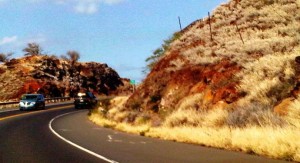Severe Drought Returns to Leeward Haleakala
By Wendy Osher

Severe drought conditions return to the leeward slopes of Maui. Photo of dry brush along the Pali section of the Honoapiilani Highway, by Wendy Osher.
The dry season in Hawai’i had a late start this year, but hit hard in August and September, according to state hydrologists.
The drought worsened after improvements reported in the spring, resulting in a return of severe drought conditions to leeward Haleakala on Maui, and extreme drought conditions to the leeward Kohala and southern Ka’u District of Hawai’i Island.
Kaua’i and Oahu developed moderate drought conditions in late September and early October, with Lihue Airport reporting their driest September on record since 1975.
The information served as the backdrop for the 2011-2012 Wet Season Outlook released today by the National Oceanic and Atmospheric Administration.
Hydrologist Kevin Kodama with the National Weather Service provided the outlook, which projects some drought recovery in Maui and Hawai’i Counties, with drought recovery more likely on Kaua’i and Oahu.
The report states that full recovery for Maui County may be elusive due to the intensity and longevity of existing drought conditions. Experts say that severe drought conditions have affected portions of the state continuously since June of 2008.
The forecast calls for a return of La Nina conditions, which are projected to be weaker in 2011-2012 than they were in the previous year.
La Nina rainfall forecasts have considerable uncertainty, according to Kodama’s report, with drier than normal conditions expected through October; and wetter than normal conditions anticipated in January through April or May.
In preparedness for the wet season, the agency recommends cleaning of gutters and drainage ditches.
For those that live in flood-prone areas, hydrologists recommend identification of evacuation routes ahead of time.
The wet season also brings increased potential for lightning strikes. In fact, the June 4, 2011 storm produced more than 22,000 lightning flashes in 30 hours over and near the main Hawaiian Islands.










